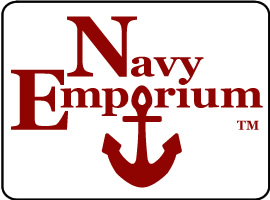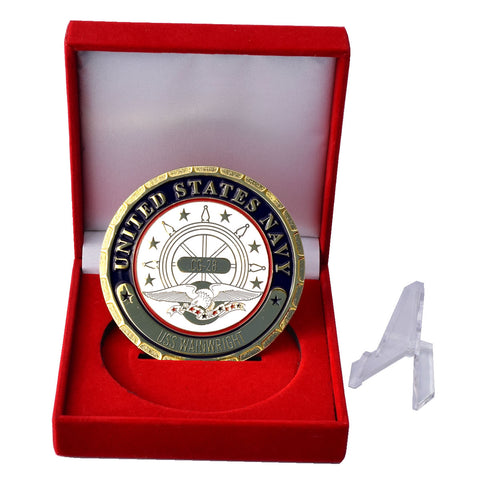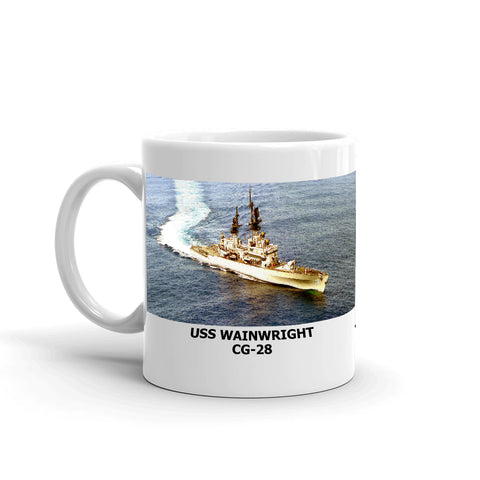The USS Wainwright CG-28, initially known as DLG-28, was a guided missile cruiser of the Belknap class that played a role in defending during the Cold War. Its construction began on January 2, 1962 at Bath Iron Works in Bath, Maine. In response to the demands of the Cold War, America needed an adaptable force. The craftsmen at Bath Iron Works meticulously crafted this vessel to meet those requirements. The ship was launched on March 15, 1965 with Mrs. Patricia Wainwright as its sponsor. Following that it, underwent outfitting to install systems and armaments for its forthcoming service.
The USS Wainwright pays tribute to a family with a history of service by adopting their name. Notably, it honors three generations of Wainwrights; Commander Jonathan Mayhew Wainwright I, who bravely served during the American Civil War; his son, Rear Admiral Richard Wainwright, a recipient of the Medal of Honor, for his actions aboard the USS Gloucester during the Spanish American War; and Rear Admiral Richards son Commander Jonathan Mayhew Wainwright III. Additionally, we must not forget General Jonathan Mayhew Wainwright IV, a hero of World War II who endured the hardships of the Bataan Death March and survived captivity. This proud lineage emphasizes the ship's identity and instills it with a legacy of bravery and dedication.
As part of the Belknap class cruisers, the USS Wainwright was at the forefront of technology during its commissioning. These cruisers were pioneers in terms of being designated as guided missile cruisers by the U.S. Navy, reflecting a shift towards strategies that heavily relied on missile weaponry. The Wainwright boasted a formidable appearance with a range of sensors, radars, and weapon systems including Terrier surface to air missiles for defense against airborne threats and advanced capabilities for anti submarine warfare. It was later upgraded to incorporate the standard missile system. The ship was equipped with a 5 inch/54 caliber gun of fulfilling dual purposes along, with rapid fire 20mm Phalanx CIWS to counter any immediate threats. Furthermore, it also carried an array of torpedoes to effectively handle combat situations. Distinguished by its structure and mast, the Wainwright was easily recognizable and served as a symbol of American naval strength.
Throughout its thirty years of service, the USS Wainwright established a reputation within the US Navy. Its versatility and impressive capabilities allowed it to serve roles from escorting fleets and commanding air defenses to representing diplomacy in waters. The Wainwright actively participated in operations, including the standoff during the 1973 Yom Kippur War and its significant involvement in Operation Praying Mantis in 1988. It engaged forces demonstrating its combat prowess and highlighting how guided missile cruisers have become crucial elements of modern naval strategies. Its service during moments emphasized the importance of such adaptable ships in maintaining peace and projecting power.
The USS Wainwright belonged to the Belknap class cruisers, which were specifically designed to combine anti anti submarine warfare capabilities with powerful firepower for engaging both surface threats. These ships served a purpose by safeguarding aircraft carriers and convoys while also being capable of launching actions against surface vessels as well as aerial adversaries. The presence of these ships played a role as a deterrent during the geopolitical climate of the Cold War, where naval supremacy held immense importance. The Belknap class ships, equipped with the RIM 2 Terrier missile system, showcased their significance in the US fleet. This firmly established them as an element in America's defense throughout the part of the 20th century.
On November 8, 1966 a formal ceremony marked the commissioning of the USS Wainwright. With this event, the ship officially became a part of the United States Navy's fleet. The officers and enlisted personnel led by their commanding officer took charge on this occasion. These individuals would define the ships character and accomplishments in years to come. The commissioning allowed for utilization of her capabilities by integrating her into operational plans. It set the stage for contributions made by USS Wainwright to security and military operations over subsequent decades. Brimming with pride and grandeur, USS Wainwright stood prepared for her voyage- a beginning to a remarkable career in service to her nation.
Structure, Technology, Armament and Weaponry
The USS Wainwright CG-28 served as a guided missile cruiser in the United States Navy from 1966 until 1993. It was specifically designed to excel in anti ship warfare, providing protection to carrier battle groups against various threats from the air, surface, and undersea. With a displacement of over 6,000 tons and measuring 547 feet in length and having a beam of 55 feet, the Wainwright presented an imposing figure on the seas. Its hull was constructed with a steel frame that could withstand damage during battles. As a cruiser from the Cold War era, the Wainwright incorporated command and control systems and electronics for that time period. This included the Naval Tactical Data System (NTDS) which allowed for real time information sharing and integration of data collected by its sensors.
The Wainwright boasted cutting edge technology at its time of service with a focus on targeting capabilities and communication systems. Notable technological assets included the AN/SPS 48 air search radar and AN/SPS 49(V)5 long range air search radar that enabled tracking targets over long distances. Additionally, it carried the AN/SPG 55B radar for fire control purposes.
The radar system and electronic warfare equipment on board the ship served a purpose; detecting and identifying threats as well as employing electronic countermeasures, which played a crucial role in countering Soviet era dangers. To enhance its submarine warfare capabilities, the cruiser was also equipped with advanced sonar technology.
In terms of weaponry, the USS Wainwright CG-28 was heavily armed to engage targets. It featured a missile launcher (Mk 10) of firing Terrier and later Standard missiles, providing air defense capabilities. Additionally, the ship carried two 5 inch Mk 42 guns for surface engagements and shore bombardment along with ASROC launchers designed to counter surface threats. To defend against high speed maneuvering threats, the vessel was equipped with the Phalanx Close In Weapons System (CIWS). Furthermore, it had the capability to deploy Harpoon ship missiles effectively against hostile vessels.
Apart from its armaments, the USS Wainwright also possessed an assortment of weapons and defensive measures. For submarine operations, it housed a pair of triple tube launchers designed for Mk 46 torpedoes. The cruiser also had a range of electronic warfare capabilities, including jammers and decoy launchers like the AN/SLQ 32 Electronic Warfare Suite. This suite was used to intercept, analyze, and disrupt threats. Additionally, the ship was equipped with the SRBOC (Super Rapid Blooming Offboard Chaff) system to divert enemy missiles. These systems ensured that the Wainwright could effectively deal with both unconventional threats- it highlighted the ships strategy during its operational period.
Upgrades, Mission Capabilities, and Contributions
Throughout its service life, the USS Wainwright CG-28 underwent upgrades to enhance its mission capabilities and maintain effectiveness within the fleet. Originally commissioned as a guided missile destroyer leader (DLG 28) in 1966, it was later reclassified as a guided missile cruiser (CG-28) in 1975 as part of a realignment of the Navy's surface fleet. One notable upgrade included integrating the New Threat Upgrade (NTU) program into its AEGIS combat system. This improvement enabled the ship to track and engage threats simultaneously with greater accuracy. The USS Wainwright became more capable with the addition of the SQQ 89(V) submarine warfare suite. This upgrade allowed the vessel to detect and neutralize threats effectively, making it a strong asset against both air and sub surface targets.
Great attention was given to enhancing the ships abilities well by installing two Harpoon ship missile launchers, its capability to engage surface threats at long ranges was significantly boosted. Additionally, the Wainwright was equipped with two Mk 141 quad cell launchers for Tomahawk land attack missiles, expanding its role in projecting power and providing support to ground forces from the sea. These impressive upgrades were accompanied by improvements in electronic warfare systems and modernizations of SM 1MR surface to air missiles, which provided a defense against enemy missiles and aircraft.
The USS Wainwright had mission capabilities that reflected the US Navy's need for vessels during and beyond the Cold War era. With its radar and computing systems, it excelled in air defense missions by acting as a shield for carrier battle groups. It also had the flexibility to operate independently or as part of surface action groups, projecting power and maintaining a presence in crucial maritime regions.
The USS Wainwright CG-28, a guided missile cruiser, played a role in strengthening the US Navy's surface fleet throughout its thirty years of service. With submarine warfare capabilities, it provided invaluable protection to high value units in areas where submarine threats were significant. Additionally, its cruise missiles allowed it to participate effectively in bombardment and strike operations during conflicts like the Gulf War.
The USS Wainwright CG-28 participated in operations and exercises worldwide. This demonstrated the United States maritime power and commitment to maintaining control over sea territories. The ships operational versatility was evident as it seamlessly transitioned between offensive roles, showcasing its adaptability during times of uncertainty. The history of USS Wainwright CG-28 serves as a testament to its endurance effectiveness, due to upgrades and the skill of its crew members.
USS Wainwright CG-28: Crew Memories and Camaraderie
The USS Wainwright (CG-28) holds a special place in the hearts of its former crew members, who served aboard the ship during various years. Their shared memories reflect the strong bonds formed, the challenges faced, and the enduring legacy of this remarkable naval vessel.
Clarence Dubose (E5/PN2, 1985-1988) fondly remembers the USS Wainwright as a great experience that taught him about the real world. He acknowledges the camaraderie among shipmates and the influence of fellow crew members like BMC Strickland, MS1 Persons, and BM3 Reed.
Charles Jones (BT3/SW, 1984-1989) recalls his time on the USS Wainwright as a great learning experience. He acknowledges the exceptional crew and mentions training at Guantanamo Bay. He also highlights the formidable reputation of Commanding Officers Dalrymple and Huchting.
Lonnie Campbell Jr. (QM3, 1992-1993) started in the deck department before becoming a QM. He cherishes the camaraderie and mentions fellow crew members like Hamrick, Hansford, Lay, Fizi, Rutt, and others. His time on the Wainwright is remembered as the best in his Navy life.
Todd Boxberger (BM3/SW, 1992-1993) fondly remembers his time on the USS Wainwright, even after 15 years. He expresses gratitude to his shipmates, mentioning names like BM3 Hinkley, BM1 Moore, and SN. Brewer, among others.
Ronald Abney (E5/SM2, 1982-1986) shares his appreciation for the USS Wainwright, considering it the best ship he's ever served on with the best crew. He values the true friendships formed during his time on board.
Richard 'Rick' Watson (STGC/SW, 1992-1993) misses the USS Wainwright and describes it as the best ship he had the pleasure to serve on during his 20-year career. He mentions the DECOM ceremony and the honor of serving under CO Iron Mike Fahey.
Candelario 'Candy' Rodriguez (MSSN, 1978-1979) reflects on the USS Wainwright as one of the best ships around. He fondly recalls fellow Sailors like Mike Solenburger, Brown from Hotlanta, and Pat from Baton Rouge. Rodriguez now has a blues band in California, thanks to the memories from his Navy days.
Alex 'Al' Rubio (OS1, 1986-1988) describes the USS Wainwright as "Battle Tested, Battle Proven." He expresses gratitude to the OI Crew and acknowledges the great job they did, creating lasting memories.
Dan Bowman (GMM 1, 1973-1975) proudly served in the finest Missile House and returned to claim artifacts. He fondly remembers the Missile House and its enduring shine.
Dr. Noe (OS2, 1973-1976) sends greetings to numerous shipmates, recalling their time together on the USS Wainwright. He cherishes the great years spent on the ship and expresses missing his fellow crew members.
Deployments, Role in Conflicts, Awards and Commendations
Commissioned in 1966, the USS Wainwright CG-28 served as an embodiment of the US Navy's presence and military strength through deployments. It undertook voyages across oceans worldwide to project power and safeguard interests. During its years, the USS Wainwright frequently sailed in the Mediterranean region, often working alongside the Fleet to demonstrate the United States presence and commitment to NATO allies. This versatile ship also passed through the Panama Canal for operations in the Pacific. In years during the Cold War era, it was stationed in the Persian Gulf as part of enforcing the Carter Doctrines promise to safeguard interests in that area.
The involvement of Wainwright in conflicts showcased its combat capabilities and strategic significance. One notable instance was its participation in Operation Praying Mantis on April 18, 1988. This operation took place as a response to an attack on USS Samuel B. Roberts by forces. Wainwright played a role by engaging in a naval battle alongside other Navy vessels, effectively neutralizing Iranian threats and leading to the sinking of an Iranian frigate named Sahand. This event served as a testament to Wainwright's strength and ability to deter adversaries while upholding freedom of navigation through waterways.
Throughout its thirty year service period, USS Wainwright received accolades acknowledging its performance and operational readiness. The ship was honored with awards, including campaign and service medals for its contributions during both Cold War endeavors and operations conducted in the Middle East. The USS Wainwright (CG-28) received accolades such as the Meritorious Unit Commendation and the Navy E Ribbon. The latter recognized the crews battle efficiency serving as a testament to their professionalism and skill. These honors not only symbolized the ships accomplishments but also boosted morale for those who served on this distinguished cruiser.
When it was decommissioned in 1993, the USS Wainwright (CG -28) left behind a legacy etched in history with its name carrying on through its service record. The cruisers deployments highlighted the nations strategy of maintaining a forward deployed force, capable of responding wherever needed. Its actions during conflicts have provided lessons for naval engagements. The commendations it received stand as evidence of its role within the United States Navy operations, instilling pride among present fleet members while reinforcing the enduring commitment to excellence and duty within our naval forces.
USS Wainwright CG-28 Ship Specifications
| Specification | Details |
|---|---|
| Class | Belknap Class Guided Missile Cruiser |
| Commissioned | January 8, 1966 |
| Displacement | 5,340 tons |
| Length | 547 feet |
| Beam | 54.9 feet |
| Draft | 29 feet |
| Speed | 34 knots |
| Complement | 400 |







5 comments
Years Served: 1980-1981…RE:Charles Emory Jr send me an email maybe i can help you niterider@usswainwright.org
Years Served: July 1989 – April 1990… Hey shipmates, I was abourd the Wainwright as a cook (CS1) (MS1). I came aboard just before the Med. Cruise in 1989, I worked in the general mess at first. Then I was assigned to the chief’s mess, then worked in the officer’s wardroom galley. From there I went to the Captian’s mess. Hurricane Hugo hit and it was a mess in Charleston upon our return to port.
Years Served: 1/8/1966-1968…How can I get a list of the original crew? DLG-28
On board 1970 / 1972 as an MM3 working in main control. Made last West- PAC / Around the World Cruise.
Served USS Wainwright 86-88. Number 1 Engine room and #1 Fire team. Ship at that time had 1 5 inch gun ,4 stack’s of 4 harpoon launchers. 4 R2D2 Gatleng guns,and a sm2 missile launcher. Our ship was nicknamed the Lonely Bull. We’d go anywhere anytime alone. The E’s you see on stack’s and guns, which represents dedication and qualifications. The USS Wainwright had every qualification Gold E With 4 Gold stripes. The highest recognized achievement. When we entered Operation Praying Mantis. Battle kills 2 oil platforms, 7 ship’s, and 2 fighter jets. Only loss 2 pilots from a cobra helicopter attached to our ship.